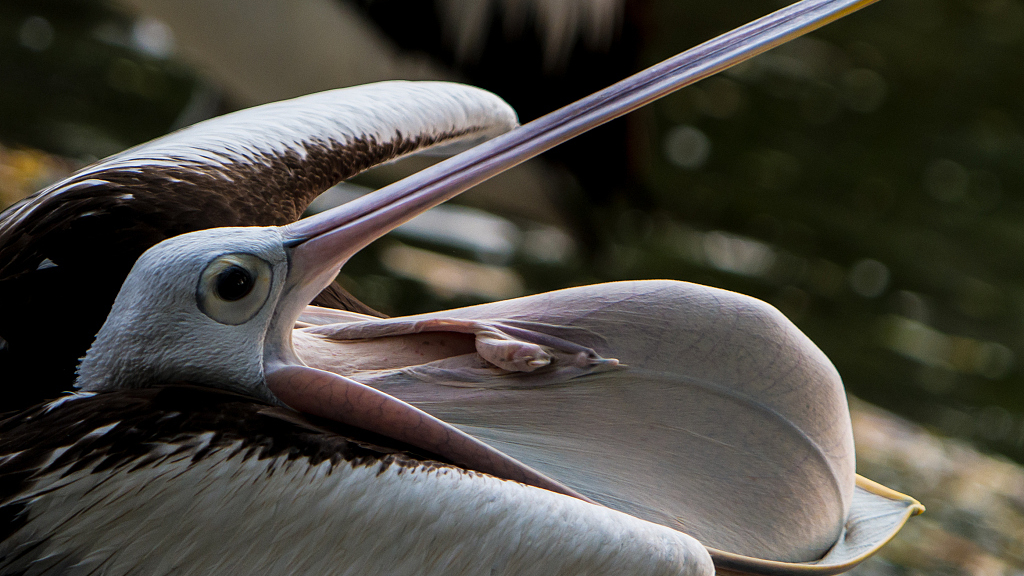
In the vast tapestry of avian diversity, the pelican stands as a peculiar masterpiece, boasting a beak that has earned it the title of “weirdest beak in the bird world.” Pelicans, belonging to the Pelecanus genus, are iconic creatures with a distinctive long beak and a captivating pouch beneath their throats, a tool honed by nature for expertly capturing prey. These magnificent birds thrive in both coastal waters and terrestrial landscapes, gracing us with their presence as they embark on daily feeding expeditions.
Despite their grand size, pelicans possess a set of traits that grant them remarkable agility in flight. Short, square tails paired with expansive wings enable them to soar gracefully through the skies. Their impressive wingspan, when coupled with their lightweight bodies—thanks to strategically placed air sacs—bestows them the ability to elegantly float atop water bodies.

Varying in size, the spectrum of pelican species spans from the modest dimensions of the brown pelican, measuring up to 1.06 meters with a weight of 2.75 kilograms and a wingspan of 1.83 meters, to the grandeur of their larger counterparts, which can tip the scales at a weight of 15 kilograms, stand around 1.83 meters tall, and stretch their wingspan to an impressive 3 meters. Remarkably, male pelicans often bear larger physiques than their female counterparts.
At the heart of the pelican’s extraordinary anatomy lies its prodigious beak, reaching lengths of nearly 46 centimeters. Beneath this impressive appendage lies a remarkable throat pouch, capable of accommodating over 11 liters of water. This pouch not only serves as a repository for sustenance but also doubles as a natural cooling mechanism. During scorching days, the pelican sways its pouch to dissipate heat.

Distributed across continents, excluding Antarctica, pelicans exhibit a penchant for warm waters. Their aptitude for aquatic life is buoyed by robust legs and webbed feet, complemented by a waterproof coat courtesy of sebum extracted from their prostate gland.
The pelican’s culinary preference primarily revolves around fish, although amphibians, turtles, crustaceans, insects, pigeons, and small mammals may occasionally grace its menu. After capturing its prey, the pelican employs a unique dining ritual. It secures the catch in its pouch, then lowers its beak to drain the water before engulfing the meal—a process that can span up to a minute. However, this ritual renders the pelican vulnerable to opportunistic birds snatching its prey.
These majestic creatures often congregate in communal herds, with group sizes reaching staggering numbers of up to 50,000. The pelican family comprises around eight distinct species, with four favoring ground nesting and the remaining four opting for tree nests.

During the breeding season, the pelican dons the mantle of monogamy, forming faithful pairs that partake in the elaborate dance of parenthood. Nest construction falls to the male, who dutifully procures the necessary materials. A clutch of eggs, often numbering two or more, is then incubated jointly by both parents for a span of 30 to 36 days.
Despite their formidable breeding success rate of up to 95%, the fledgling stage poses a significant challenge for the young pelicans. Intense competition for food during the initial weeks leads to a notable mortality rate. Yet, survival hinges on cooperative parenting, as both the mother and father participate in feeding their offspring. Interestingly, the feeding process sometimes gives rise to a perplexing phenomenon, where the chicks experience seizures and temporary unconsciousness—an enigma that remains to be unraveled by science.
The pelican, with its enigmatic beak and intricate lifestyle, epitomizes the fascinating intricacies that the natural world holds. Amid its quirks and mysteries, this avian marvel continues to inspire wonder and awe, a testament to the diversity that makes our planet a realm of perpetual discovery.



